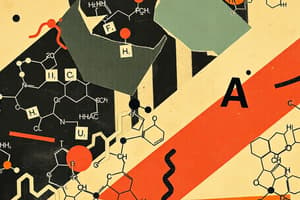Podcast
Questions and Answers
Which of the following amino acids is classified as acidic?
Which of the following amino acids is classified as acidic?
- Lysine
- Asparagine
- Aspartate (correct)
- Alanine
What characteristic defines a branched amino acid?
What characteristic defines a branched amino acid?
- Has a side chain that branches off (correct)
- Has a phenyl or phenol ring
- Contains no side chains
- Consists only of aliphatic structures
Which amino acid is considered non-branched?
Which amino acid is considered non-branched?
- Isoleucine
- Lysine (correct)
- Leucine
- Valine
Which group is present in all amino acids?
Which group is present in all amino acids?
What defines aromatic amino acids?
What defines aromatic amino acids?
Which set of amino acids are classified as basic?
Which set of amino acids are classified as basic?
Which of the following is true regarding L-amino acids?
Which of the following is true regarding L-amino acids?
Which amino acid is identified as heterocyclic?
Which amino acid is identified as heterocyclic?
Which of the following amino acids is classified as essential?
Which of the following amino acids is classified as essential?
Which of these amino acids is considered semi-essential?
Which of these amino acids is considered semi-essential?
What defines a glucogenic amino acid?
What defines a glucogenic amino acid?
Which amino acids are categorized as ketogenic?
Which amino acids are categorized as ketogenic?
What is one of the biomedical functions of amino acids?
What is one of the biomedical functions of amino acids?
Which amino acids are classified as mixed amino acids?
Which amino acids are classified as mixed amino acids?
Which of the following amino acids is essential for both children and adults?
Which of the following amino acids is essential for both children and adults?
Which statement best describes non-essential amino acids?
Which statement best describes non-essential amino acids?
Flashcards are hidden until you start studying
Study Notes
Amino Acid Structure
- There are roughly 300 amino acids found in nature, but only 20 of them are present in proteins.
- Every amino acid has four groups attached to its alpha (α) carbon:
- Amino group (NH2)
- Carboxyl group (COOH)
- Hydrogen atom (H)
- Side chain or radical group (R)
Amino Acid Characteristics
- All amino acids are α-amino acids, meaning the amino group is attached to the second carbon (next to the carboxyl group).
- Amino acids are L-Amino acids, meaning the α-amino group is in the left-side configuration.
Chemical Classification of Amino Acids
- Acidic: Contain more than one -COOH group (e.g., Aspartate and Glutamate).
- Basic: Contain more than one -NH2 group (e.g., Ornithine, Lysine, Arginine, and Histidine).
- Neutral: Contain one COOH and one -NH2 group (e.g., Glycine, Alanine).
- Branched: Valine, Leucine, and Isoleucine.
- Non-Branched: All other amino acids.
- Aromatic: Contain phenyl or phenol rings (Phenylalanine, Tyrosine).
- Heterocyclic: Contain other types of rings (Tryptophan, Histidine, Proline, and Hydroxyproline).
- Aliphatic: Do not contain any rings.
Nutritional Classification of Amino Acids
- Essential: Essential amino acids are not synthesized in the body and must be obtained through diet. Their deficiency can affect growth and health.
- Threonine
- Valine
- Leucine
- Isoleucine
- Lysine
- Methionine
- Phenylalanine
- Tryptophan
- Semi-Essential: Not required for adults but are essential for children. Synthesized in the body, but not enough for children.
- Histidine
- Arginine
- Non-Essential: Can be synthesized in the body.
- All other amino acids.
Metabolic Classification of Amino Acids
- Ketogenic: Metabolized to ketone bodies (e.g., Leucine and Lysine).
- Mixed (Ketogenic and Glucogenic): Metabolized to both glucose and ketone bodies (e.g., Threonine, Isoleucine, Phenylalanine, Tyrosine, and Tryptophan).
- Glucogenic: Metabolized to glucose (e.g., All other amino acids).
Functions (Biomedical Importance) of Amino Acids:
- Structural:
- Part of body peptides and proteins (e.g., plasma proteins, tissue proteins, enzymes).
- Found in hormones (e.g., Thyroxine and catecholamines)
- Present in amines (e.g., Histamine: a vasodilator).
- Neurotransmitters: (e.g., Glycine, Glutamate).
- Detoxication: (e.g., Glycine).
- Health and Growth: Important for infants and adults.
Studying That Suits You
Use AI to generate personalized quizzes and flashcards to suit your learning preferences.




